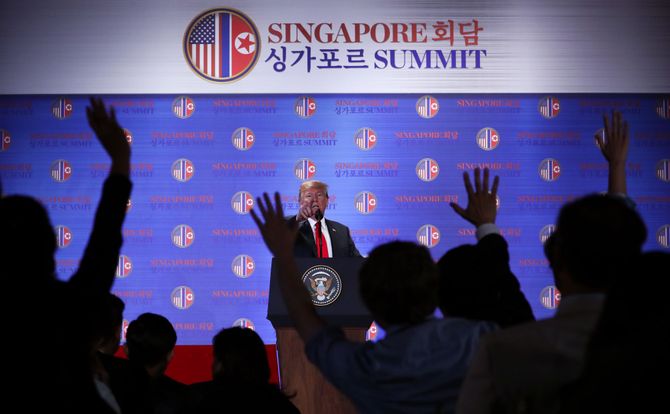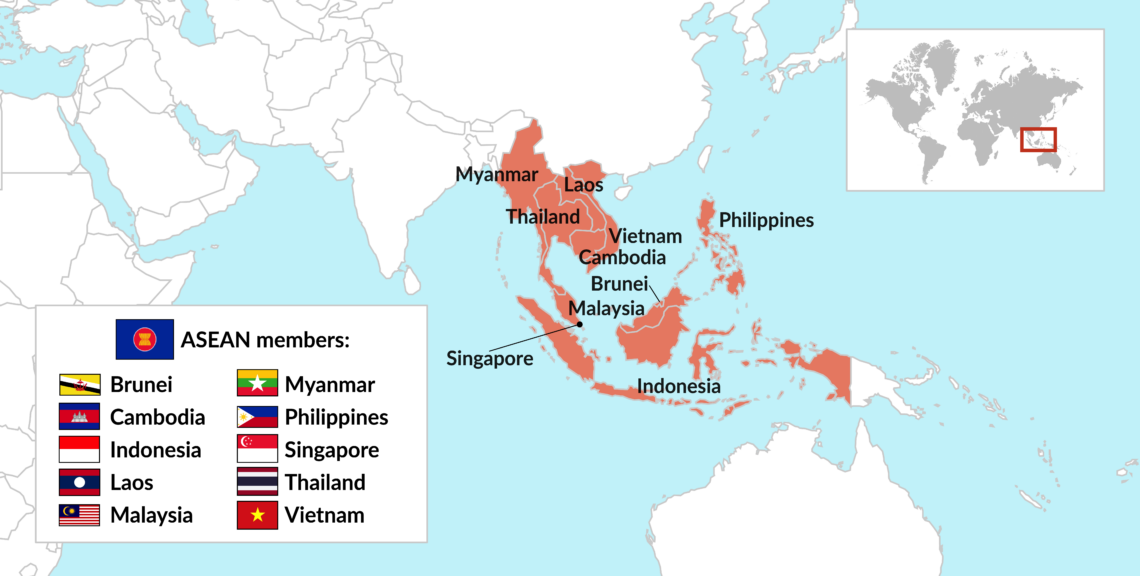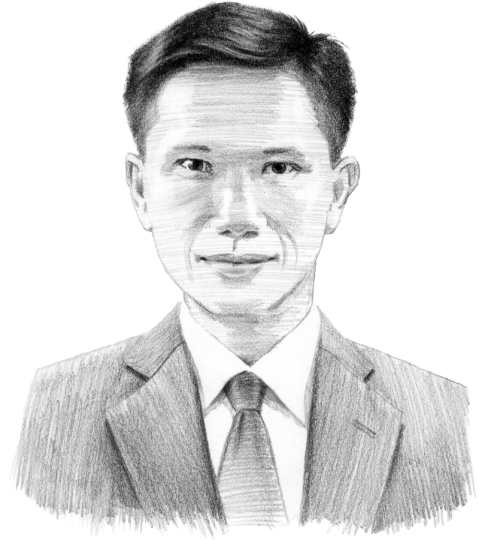Regional shifts are marginalizing ASEAN
During the geopolitical shifts in East Asia and the Indo-Pacific, the Association of Southeast Asian Nations has been conspicuously absent. Split over Chinese activity in the South China Sea – the organization is not ready to face new challenges. If ASEAN becomes irrelevant, it will also impact big players, such as the U.S. and China.

In a nutshell
- ASEAN has little influence on the geopolitical shifts occurring in Asia
- The group is already split over Chinese activity in the region
- The changes threaten to make ASEAN irrelevant
- The big global powers stand to gain from maintaining ASEAN’s influence
When Singapore pulled off a diplomatic coup by hosting the summit between United States President Donald Trump and North Korean leader Kim Jong-un, there was one conspicuous absence. The Association of Southeast Asian Nations (ASEAN) was nowhere in the mix, even though Singapore is the current chair of the organization. Ongoing geopolitical realignments around the Korean Peninsula and across the Pacific and Indian oceans via the so-called “free and open Indo-Pacific” (FOIP) now threaten to overwhelm ASEAN, which is split over China’s growing assertiveness in the region.
However, if ASEAN becomes more ineffectual, unable to build geopolitical bridges and broker regional peace and stability, it will not just be its 10 members that suffer a loss of influence. The major powers on the East Asian landmass and across the Indo-Pacific would bear the brunt of rising tensions without a third-party platform to mitigate their differences.
President Trump alluded to the Indo-Pacific in speeches during his Asian tour late last year, but the geostrategic construct was only taken seriously when it was codified in the U.S.’s National Security Strategy and its National Defense Strategy after his 12-day trip. It was reinforced by the sudden renaming of the U.S. Pacific Command into the Indo-Pacific Command. The FOIP is now a serious geopolitical strategy to be reckoned with, promoted by a quadrilateral group of countries, led by Japan, in close partnership with Australia, India and the U.S.
Free and open Indo-Pacific
The FOIP had its origins just over a decade ago when Japanese Prime Minister Shinzo Abe invited India to join what was then a trilateral strategic dialogue. The consequent “Quad” is now seen as the FOIP’s main driver, although the Indo-Pacific strategy is region-wide and multilateral, and open to including other countries.
It is early days for the FOIP as a framework for regional organization. But its implications are already far-reaching for China, ASEAN and the world. First, China will see the FOIP as a geopolitical affront, an encirclement of sorts by its three main rivals, the U.S., Japan, and India. Australia also has locked horns with China over what Canberra sees as dubious Chinese public diplomacy on its soil to exercise undue leverage.
For India, the arena of contest with China is largely confined to South Asia, especially Pakistan, which is India’s immediate security concern. For the U.S., geopolitical and economic competition with China spans the two land masses on either side of the Pacific. Japan is keen to push back against Beijing in the East China Sea and to offer alternatives to Chinese “checkbook diplomacy” in Southeast Asia.
At issue will be how China deals with the FOIP. If Beijing sees it as an attempt to create a new regional order at China’s expense, it will push back. This happened before with the “pivot to Asia” by the previous U.S. administration under President Barack Obama. China’s takeover of the South China Sea broadly parallels the timeline of the Obama strategy in Asia, and the U.S. had no answer for it.
Beijing considers itself entitled to reclaim land and construct artificial islands in the South China Sea.
In the South China Sea, Beijing considers itself entitled, by virtue of history, to reclaim land, as well as to construct and “weaponize” artificial islands. This is occurring near ASEAN’s maritime members, particularly the Philippines and Vietnam. Beijing now operates several of these artificial islands as forward military bases, a practice recently exemplified by a naval exercise revolving around the Liaoning aircraft carrier and presided over by none other than President Xi Jinping.
Rising tension
Clearly, ASEAN is already overwhelmed by China. Now the FOIP poses more challenges. Geopolitical tension between the Quad powers and China is likely to ratchet up. ASEAN’s major rationale for existence has been to keep the major powers at bay and in balance. This goal will be harder to achieve if the confrontation between major powers intensifies.
Additionally, the expansion of the U.S.’s military presence throughout the neighborhood risks escalation. Lest we forget, the Trans-Pacific Partnership (TPP) began life as a limited foursome cooperation among Brunei, Chile, New Zealand and Singapore. When the U.S. hopped on the TPP bandwagon, the trade-liberalization vehicle gained momentum, although the Trump administration withdrew from it in the end. As the U.S. is now fully on board the FOIP, it may similarly take off – to the detriment of regional peace and stability, depending on China’s reaction.
Facts & figures
ASEAN: losing influence

Moreover, the FOIP is a challenge to ASEAN centrality. The group has been split over China’s aggressive moves in the South China Sea. Beijing can essentially exercise a veto over any collective ASEAN position via Cambodia, although Laos and Brunei are also tight with Beijing. Moreover, the organization has no answer for the crisis in Myanmar’s Rakhine state, where atrocities against the Rohingya Muslim population have created 700,000 refugees and made ASEAN look irrelevant.
The members of the Quad will insist that ASEAN is still front and center as a regional player. But the FOIP has the potential to eclipse ASEAN by pursuing the Quad’s goals in ways that do not require the group to be in the driver’s seat.
Korean dialogue
Adding to the FOIP dilemma for ASEAN are the recent inter-Korea breakthrough and the Trump-Kim summit. The June meeting in Singapore drastically changed the Asian security outlook. There is likely to be a sea change in the security environments of the Korean Peninsula and Northeast Asia more broadly, with implications for the major powers in Asia and beyond.
For President Trump, the summit results have not been portrayed favorably, because he is disliked in many parts of the world. Many analysts have said the summit amounted to little. Others have insinuated that President Trump was duped by Kim Jong-un. The latter, head of a dictatorship seen as a global outcast, got equal treatment from the leader of the world’s preeminent superpower. For Mr. Kim, it was a global coming out party with immediate benefits. President Trump faces plenty of disdain for his blustery style and disrespect for established norms. Yet his administration has managed to bring a pariah regime to the negotiating table.
It would not make sense for the Kim regime to get rid of its nuclear weapons when they are its chief bargaining tool.
It remains unclear what “denuclearization” means for North Korea and the U.S. Obviously, North Korea is the only country with nuclear weapons on the Korean Peninsula. Thus, denuclearization must mean the elimination of North Korea’s nuclear program in a “complete, verifiable and irreversible dismantlement,” known as “CVID.” But it would not make sense for the Kim regime to get rid of its nuclear weapons when they are its chief bargaining tool and security guarantee.
What “denuclearization” must mean to Pyongyang is a Korean Peninsula devoid of U.S. military presence. The U.S. is a preeminent nuclear power, and its security guarantee for South Korea implicitly covers all available military capabilities.
Shedding more light on the knotty issue of denuclearization is the April 27, 2018 Panmunjom Declaration between North and South Korea. The Trump-Kim joint statement upholds and centers on this watershed agreement. This means that the U.S. is now bound to follow the stipulations between North and South Korea, which guides the Trump-Kim summit statement.
U.S. withdrawal?
It would be a profound development if denuclearization leads to U.S. military withdrawal from the Korean Peninsula. This would allow the two Koreas to cultivate long-term relations, perhaps including reunification. China would gain if U.S. military bases so close to its homeland are removed.
North Korea would be more secure, although the “verifiable” component of the agreement may be a sticking point. Once the U.S. starts leaving, it will have less leverage to verify or insist on other demands. For South Korea, this is a huge and calculated gamble. Successive generations of South Koreans have had to pay an incalculable price and make untold sacrifices to face North Korea’s constant threats and intimidation. The South Koreans will likely see the Trump-Kim statement and the reaffirmation of the Panmunjom Declaration as a worthwhile risk.
For Japan, any U.S. military retreat from Northeast Asia will bode ill for its security considerations.
For Japan, any U.S. military retreat from Northeast Asia will bode ill for its security considerations. Japan has been mulling its own defense buildup for years, and what happens now on the Korean Peninsula may embolden hawkish Japanese security planners to bite the bullet and beef up their own defense capabilities irrespective of U.S. commitments. It might be time for Japan to normalize its defense policy, with fewer constraints from its pacifist constitution.
Like China, Russia would gain from a pared-down U.S. military presence in South Korea. Friendlier inter-Korea relations will be a boon for Russian economic development. The changing Northeast Asian geopolitical equation would likely boost trade and development as well as infrastructure on the Eurasian landmass, centering on China and Russia.
Scenarios
For ASEAN, it would have been ideal to host the Trump-Kim summit as a regional grouping. However, ASEAN’s rotational chair, Singapore, touted itself on this occasion as a peacemaker and bridge-builder, almost a “Geneva of the East.” So ASEAN was irrelevant in the Trump-Kim meeting, even though the group has taken pride for more than two decades in counting North Korea as a party to its ASEAN Regional Forum. For all of its promotion of regional security initiatives over the years, progress on the biggest security problem in Asia has been made without ASEAN’s involvement.
ASEAN must be careful. What happens in Northeast Asia will have an impact on Southeast Asia. If the U.S. becomes less reliable, Japan may have to step up, while China towers over the rest and the Korean Peninsula transforms into a new state. These profound shifts are taking place at a time when ASEAN is at its nadir, divided from the inside and pressed from the outside by bigger players. It would be tempting to dismiss ASEAN for its inability to put its house in order. Yet outsiders have an inherent interest in maintaining the group’s relevance.
There are two main scenarios at work – either ASEAN becomes further divided and weakened or it regains cohesion and influence. If the organization falls by the wayside, the region will lose a facilitator of regional peace and stability. So it is not just in the interest of ASEAN to get its collective act together. It also behooves major external partners, particularly China and the U.S., to ensure that the group remains effective.
However, the ongoing situation points to the first scenario. ASEAN’s internal divisions appear likely to widen, while China’s regional belligerence will preclude the association from playing an effective regional role. This means Asia is likely to face more geopolitical headwinds, even though they bode ill for all.








